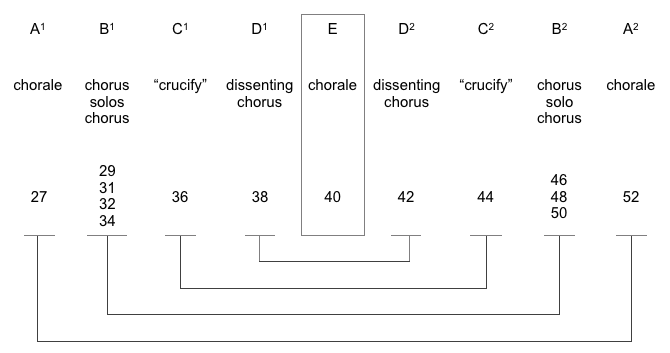If we omit the passages of recitative (which serve to tell the story and move the plot along), and focus merely on the arias and choruses / chorales, the following palindromic pattern emerges. (The brackets link those movements which are musically very similar, and in some cases almost identical.) It surely cannot be an accident that the centre of this palindrome is movement 40 – the number of days in Lent.

The St John Passion manifests itself therefore as a compelling biblical narration of the crucifixion story, with a penetrating reflection of the meaning of the events as described by John (or his followers). Listeners find themselves alternating between active participation in the events and meaningful contemplation. Bach’s fidelity to John is almost totally uncompromising: of the 82 verses in the gospel story, not one is omitted, shortened or altered in any way. However, Bach does include part of one additional dramatic verse, stolen from St Matthew’s Gospel, presumably to increase the emotional impact of Peter’s denial (see no. 18 below), and he also includes Matthew’s description of the events immediately following Christ’s death (see no. 61 below), which John omits. In this passion the audience is invited to identify clearly with the suffering of Christ through the arias. The sentiments they express are those of the universal Christ. Peter’s remorse is our remorse; it is we who sin and we who are liberated from that sin by the suffering of Christ. The conclusion of the St John Passion is very different from that of the Matthew. It is affirming, confident and assuredly looking forward to the life beyond, whereas Matthew leaves us simply with entombment.
After its first performance Bach gave three further performances, with small revisions, on the Good Fridays of 1725, 1730 and 1746. (For the 1725 performance the opening chorus was dropped completely and replaced by a chorale based chorus on the hymn O Mensch bewein dein Sünde gross which, two years later, ended up as the closing chorus of the first part of the St Matthew Passion.) Inconceivable as it may seem today, there was little interest in Bach’s music after his death as the new, fashionable, classical style emerged and the musical focus swung to Vienna. Even towards the end of his own lifetime, Bach’s style was considered by some to be outdated and turgid. Numerous criticisms appeared in print in the late 1730s and 1740s, written by various Leipzig journalists and musicians, accusing Bach of being “out of touch” and “too serious”. It is revealing to note that his own son, C.P.E. Bach, during the last twenty years of his life spent as Kappelmeister in Hamburg’s five principal churches (a position very similar to his father’s in Leipzig), did not perform a single work written by his fathe, almost as if he was embarrassed by the old school which his father represented.
The Yorkshire pianist and composer William Sterndale Bennett (1816-1875) formed the Bach Society (later reformed as the London Bach Choir) in 1849 with the sole intention of introducing Bach’s music to the English public. Helen Johnston, a student at Queen's College London, translated the libretto, and Bennett conducted the first British performance of the work, in English, at the Hanover Square Rooms in London on 6 April 1857.
Peter Parfitt